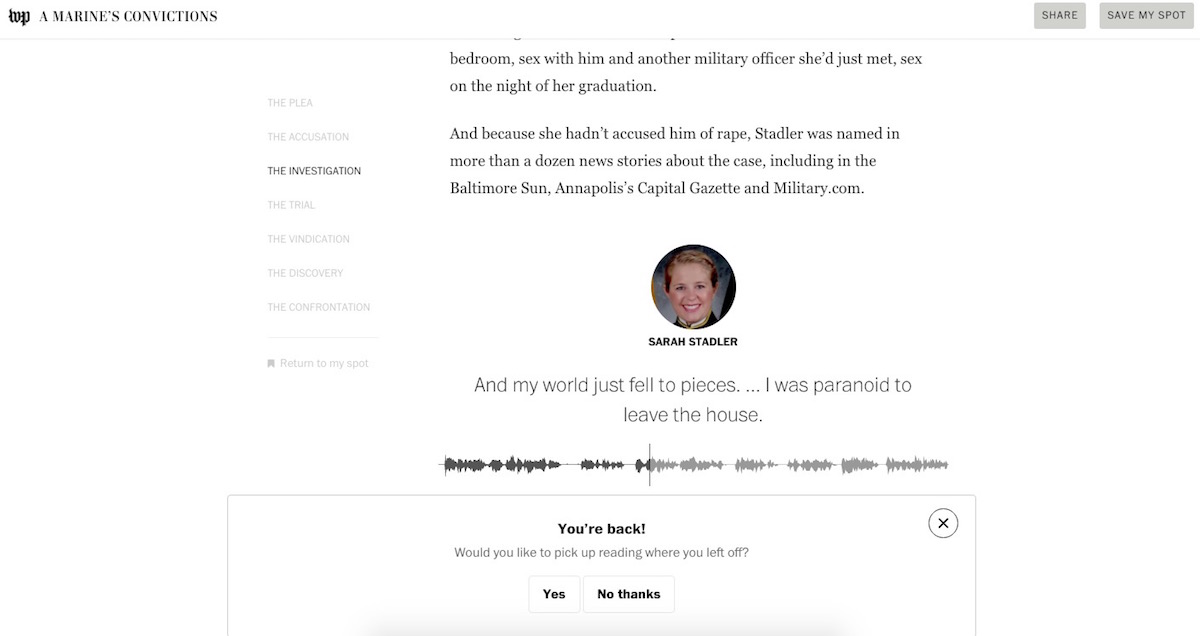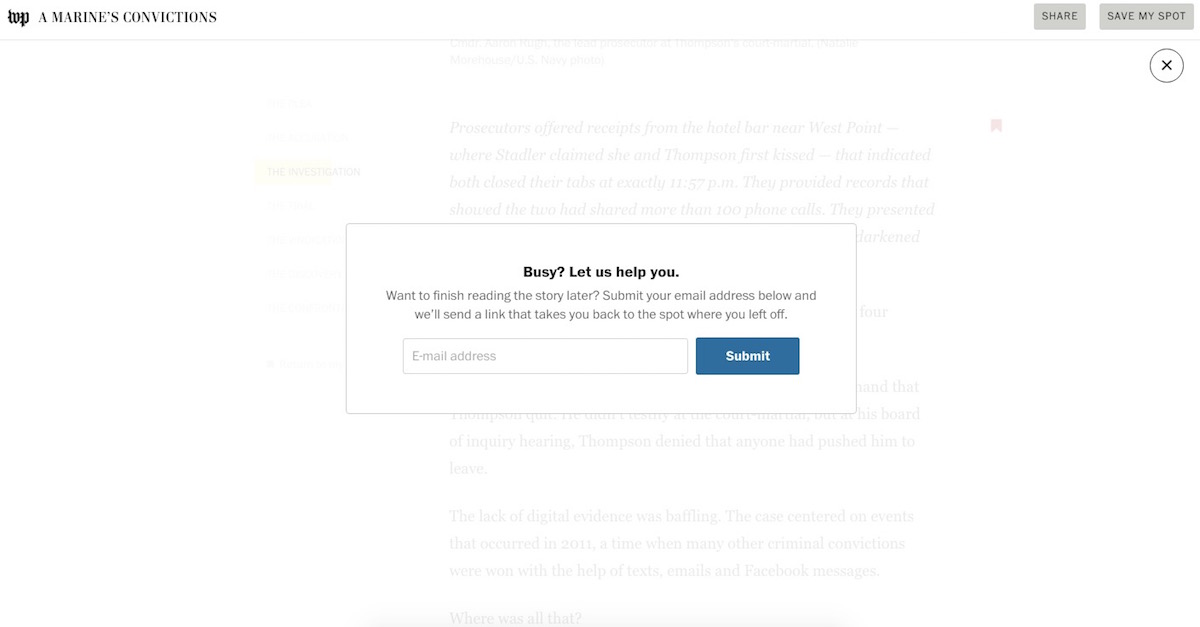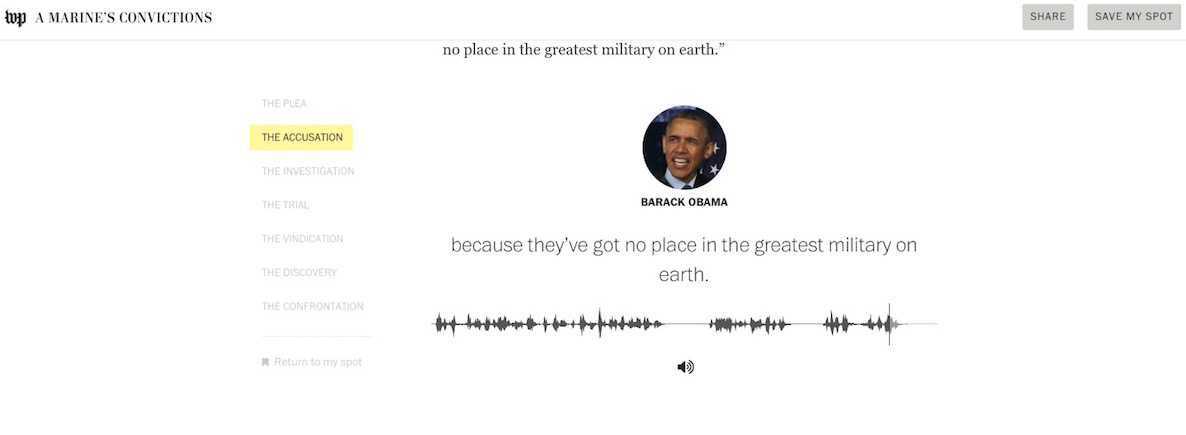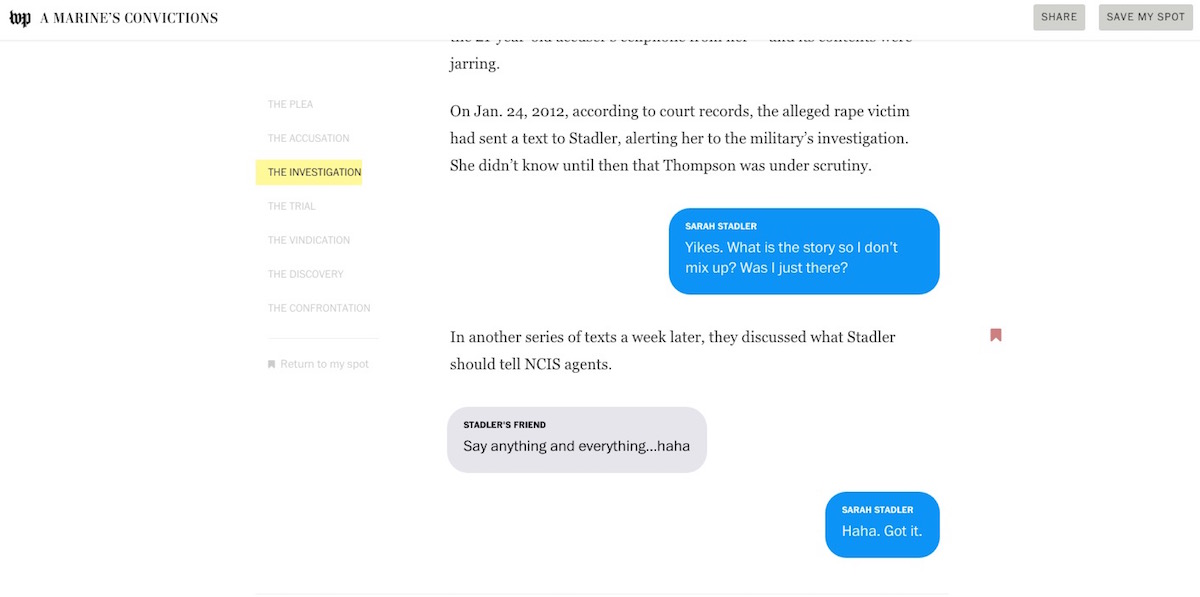
On Thursday, after more than a year and a half of reporting, The Washington Post published a story on a Marine’s attempt to clear his name after a sexual assault investigation. The piece, by reporter John Woodrow Cox, is long — more than 8,000 words, divided into seven chapters — so the Post introduced a number of new features in its online presentation to try to make it more manageable for readers on both desktop and mobile.
Among them: a bookmark tool, which lets readers save their spot in the story. Readers can enter their email address, and the Post will send them a link with a unique URL that will allow them to come back to the same spot on any device.

If readers leave the page and open it again in the same browser, the Post will ask them if they want to return to the spot where they left off.

And if a reader is inactive on the story for more than five minutes, a notification will pop up that will ask if they want to save their spot.

“The idea behind all of that different saving mechanism was that since this is such a long story, we wanted people to read it at a time that was convenient for them, and not have to come back and struggle through, ‘Where was I?’ or feel guilty about not being able to read it all the way through,” said Kat Downs, the Post’s graphics director. “We thought a lot about how to help them find their place.”
The Post isn’t the only outlet experimenting with ways to make reading long features easier. Last fall, The New Yorker introduced a similar widget that tried to guess when a reader is about to leave a story, based on scrolling behavior, and pops up to ask if they want an email reminder to come back to it.The first discussions about how to design the Post story began in the fall, Downs said. The majority of the work on the design began about a month ago, with developer and designer Matt Callahan focusing primarily on the project.
Other interactive features include embedded audio clips with subtitles, so users can still read what was being said even if they don’t have headphones or don’t want to turn up their volume.

Also, at several parts throughout the story when text-message conversations are referenced, simulated messages appear in the body of the text.

Earlier this week, a few days before the story was published, the Post published a teaser for the story. Readers could enter their email address and then they’d get an email with the first few grafs of the story as soon as it was published. Downs said “hundreds” signed up. The Post, she said, is going to continue to examine ways to use email to deliver stories to readers.
“That’s an experiment in how we can help make reading our stories as simple as possible,” Downs said. “It’s going to come straight to you. It’s going to come to your inbox.”
The interactive was also built atop the foundations of previous interactives the Post has created in recent months. Downs pointed to two stories — one on the Clintons’ donor network and the other on a local Washington, D.C. photographer — that were the basis for this most recent story.
“We built some infrastructure for those projects to pull stories, photography, and notes out of our CMS, Methode, and then have the ability to do custom design work around them in a way that we weren’t able to do before,” Downs said.
“For this story, things like the chapters, the audio pieces, the various integrations with the text messages, those are the types of things we can put hooks in the CMS and then when the content comes out of the CMS, we add all of those things and it’s baked into a page and then published,” she continued. “That has been awesome, because it’s let us do a lot more interesting things in line in the story while [editors and reporters] are still writing or moving things around in the CMS.”
For the Clinton interactive, five Post staffers had to work on building and designing all the features, but for the most recent features, only one developer, Callahan, was needed to create it. Designer Virginia Singarayar was also involved in the design work.
“He can just focus on designing the experience and developing the core features of it — which in this case would be the bookmarking, the sound, and the text messaging — and not have to worry about the basic infrastructure pieces,” Downs said.
In the post-Snow Fall era, publishers of all sorts have been creating immersive interactive stories. One of the challenges with these types of presentations has been converting them from work-intensive one-offs into repeatable toolkits that can be integrated into daily coverage.
Downs said she hopes the Post will be able to integrate some of the functionalities from this particular feature into other narratives or even regular coverage if they find that readers are using the features. When we spoke Thursday afternoon, a few hours after the story published, Downs said it was too soon to tell how the features were doing.
“One thing we do a lot of is testing and performance analysis on our own work,” she said. “With this experiment, what we’re looking for is: Do people bookmark? What’s their behavior? Is it with a bookmarklet? Is it copying the link? Is it getting it in an email? Do they return? If so, how often? How are they using it? Once we understand that better, we can improve the experience, and then we can roll it out to more of these stories. And if it’s super successful, then we would expand it into something that’s available in a broader way on the site.”